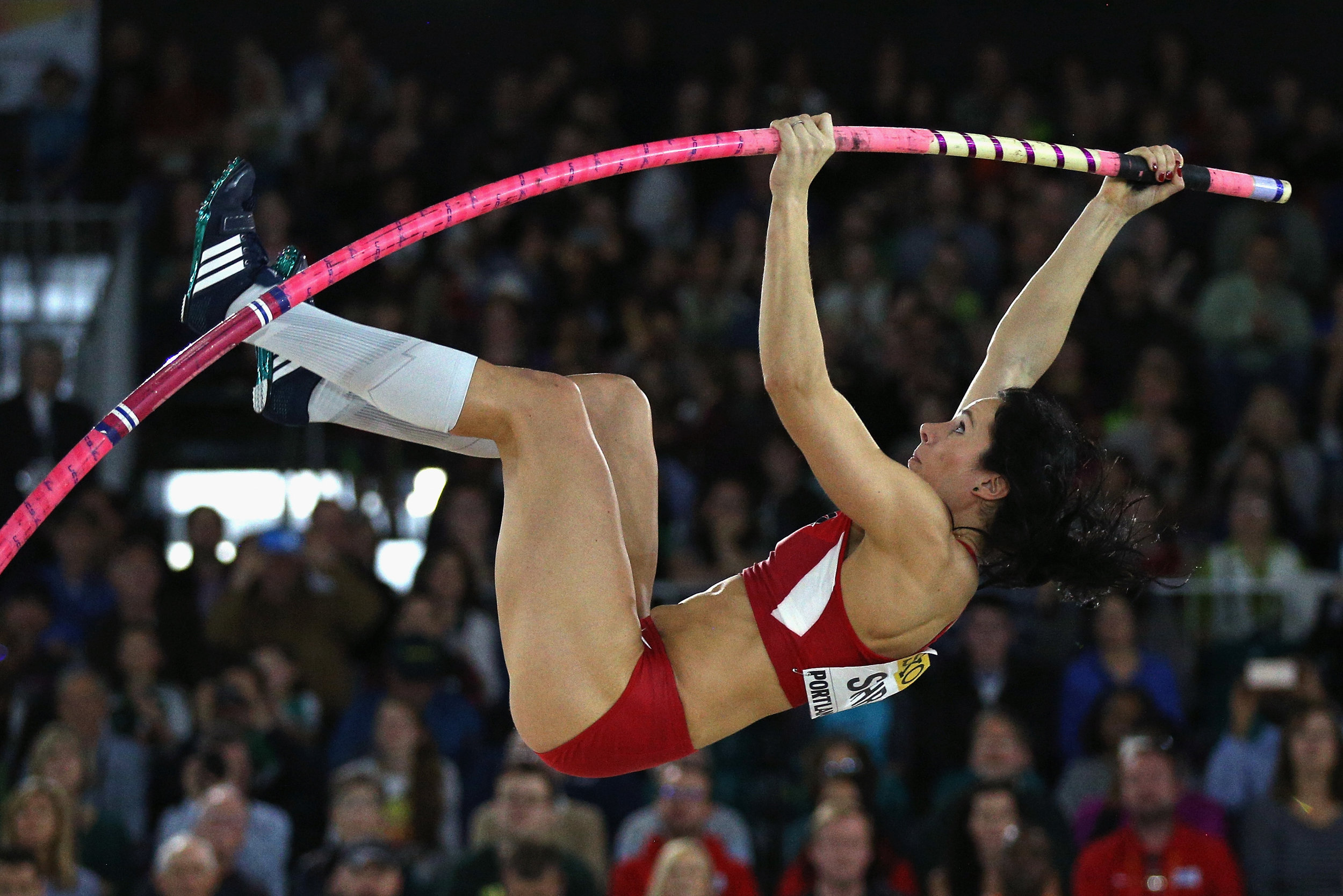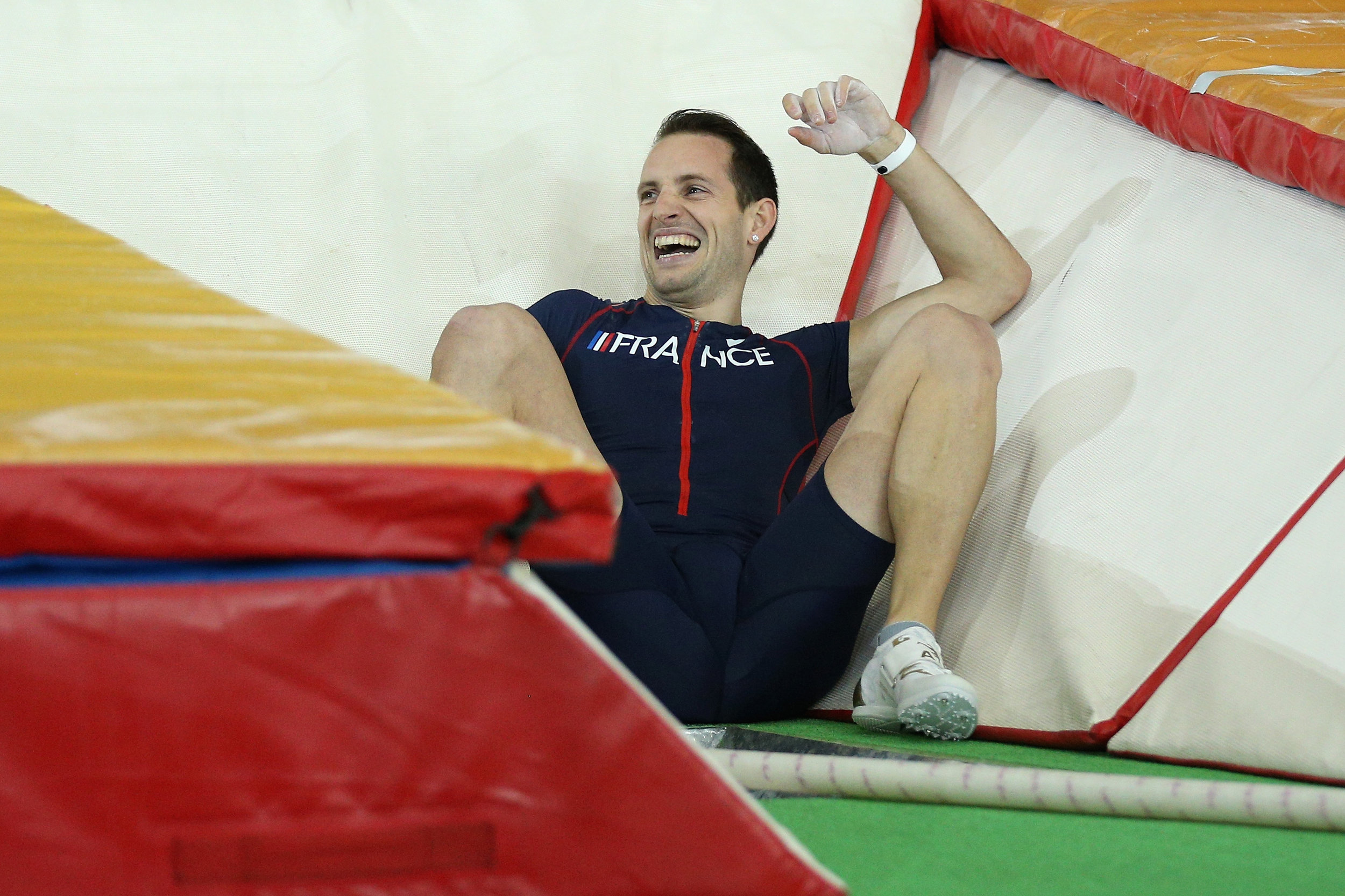PORTLAND, Ore. — Let’s get the joke out of the way early. For a sport savaged by months of doping stories, it turns out there’s a legal marijuana store literally across the street from the Oregon Convention Center, site of the 2016 track and field world indoor championship, which features a groovy, granola-crunchy green track. Can’t make this stuff up. Seriously, now: track and field arrives for the 2016 world indoors, a four-day run that got underway Thursday night, at an inflection point.
Since Sebastian Coe was elected president last August of track’s world governing body, the International Assn. of Athletics Federations, the headlines have mostly been grim. Claims of rampant corruption in the regime of former IAAF president Lamine Diack — allegations that Diack's administration was ripe with conflict of interest, graft, money for cover-ups. And, of course, doping, doping, doping. Russians, Russians, Russians. Oh, and how about the Kenyans, Ethiopians, Moroccans and more?
Wait — what’s this? UK Anti-Doping announces Wednesday a life ban against a track coach there, Dr. George Skafidis, in the wake of nine, count them, nine anti-doping violations, all relating to sprinter Bernice Wilson. In Britain? What?
The focus Thursday shifted to the sport itself, with the IAAF and local organizers, led by Vin Lananna, giving the first night of the championships over entirely to the pole vault. France's Renaud Lavillenie won the men’s event, setting a world indoor championships record, 6.02 meters, or 19 feet 9 inches. The world record, which Lavillenie set two years ago, is 6.16, 20-2 1/2. On Thursday, he made three attempts at a new world record, 6.17, 20-2 3/4. No go. American Sam Kendricks took second, clearing 5.80, 19-0 1/4. On the women's side, the U.S. went one-two, Jenn Suhr winning in a championship-record 4.90, 16-0 3/4, Sandi Morris taking second in 4.85, 15-11. As evidence of the upswing in women's pole vaulting, Thursday's competition marked the first time four women in the same competition cleared 4.80, 15-9.
"I think the Summer Olympics are going to be pretty crazy," Morris said afterward.
As the vaulters did their thing, KC and the Sunshine Band could be heard belting out their mid-'70s anthem, “That’s the way (I like it),” just one of the musical numbers featured on a loop that played over the convention speakers. In another twist, the vaulters got individual introductions — each athlete running in turn into the arena down a ramp, his or her name in lights.
Medal ceremonies: back downtown at Pioneer Courthouse Square, with more music and that Portlandia hipster vibe.
Attendance Thursday at the convention center: a robust 6,924.
It's like track and field was, you know, making a genuine effort to be more interesting. And, even, innovating.
This is the reality of what is happening with Coe, in particular, and that is particularly worth noting at the start of these championships, the first world indoors in the United States since 1987.
“The USA has historically been the powerhouse of track and field,” Coe said earlier Thursday at a sun-splashed news conference in that square. “Yet given its great economic power, it is still a country where the general perception of track and field is low. The regeneration of that is taking place here in Oregon and I genuinely believe this will be a reawakening of track and field in this country. This is a new and exciting chapter in the history of our sport."
Let's be real: that's going to take time.
Things were broken. Now they have to get fixed. Coe is the guy to fix them. New chapters, regeneration, reawakening — whatever label you like — don’t just happen overnight.
Which is why the many cries for Coe’s resignation are seriously misplaced.
As Coe said at that news conference in that square, “Our sport is still strong. Not to deny we haven’t gone through challenging, dark days.”
Later, asked specifically whether he believes there are clean Russian athletes, a ridiculous question in its own right, as if an entire country of 140 million people can’t produce one soul that competes without drugs, he said, “I’m sure there are. But the reality is we need to get the athletes,” wherever in the world they might be, “back into systems that people are trusting.”
That's half of what's what. Here is the other: doping is not just a track and field problem (hello, tennis star Maria Sharapova, swim champion Yulia Efimova and others now looking at meldonium issues). It is not just a Russia problem.
“We are responsible for our sport,” Coe said. “We are not the world’s policeman.”
A World Anti-Doping Agency-commissioned report — the first part delivered in November, the second in January — suggested that Diack ran a closely held conspiracy to cover up certain doping results, mostly in Russia.
Diack and his longtime lawyer, Herbert Cissé, are said to be facing criminal inquiry in France.
Last week, the IAAF’s policy-making council met in Monaco, the federation’s longtime base.
Process isn’t sexy. Process takes time. The press loves (even a hint of) negativity.
At the same time, Coe was duly elected after a hard-fought campaign, defeating the former pole vault legend Sergey Bubka. That means Coe earned — better, deserves — the opportunity to effect change.
The council was met with 51 measures. It approved 51.
It’s a measure of how into-the-21st century the IAAF has to go, alternatively an indicator of how Diack ran the federation for 16 years as more or less a personal fiefdom, that a good number of the 51 deal with basic, albeit essential, governance items.
For instance, things like getting double signatories on checks. Or job descriptions. Or standard HR controls.
Any institutional change is a combination of change wrought from without and within. Coe is — this is key to understand — a change agent.
So, too, Stephanie Hightower, the USA Track & Field president who was elected last August to the IAAF council.
As the USATF board said in December 2014, in a statement when it went with Hightower instead of the longtime U.S. representative to the IAAF, Bob Hersh:
“Change is difficult for any organization. It is especially difficult when it involves long-serving officials. In 2015, there will be significant, structural change at the IAAF – with their leadership, with their direction, vision and politics. This is a different era and a different time. We think Stephanie Hightower provides us with the best chance to move forward as part of that change.”
From 2011-15, Hersh had been the senior IAAF vice president, Coe one of three other vice presidents.
Once Coe was elected, he immediately turned in part to Hightower and to Frankie Fredericks, the former sprinter from Namibia who for years has been making a new career in sports administration.
Some have groused, and loudly, that as an IAAF vice president, Coe “must have known” what was going on with Diack.
Using that same logic, why aren’t the many critics of the USATF process by which Hightower was selected to run for the IAAF council asking the same about Hersh?
This, understand, is a rhetorical question — not what Hersh did or did not know. But those who have been often been the loudest in their criticism are not being consistent. You want to criticize Coe because he was vice president — but think it was somehow wrong for USATF not to re-appoint Hersh, who as the No. 2 man, the senior VP, should have been most closely involved with the organization and with Diack?
Indeed, the suggestion that Coe “must have known” itself betrays logic.
The IAAF council met maybe three or four times a year. That’s roughly 10 days of 365. Coe had been an IAAF vice president since 2007; from 2005-12, he was thoroughly occupied as boss of the London Olympics.
It’s a little bit like being vice president of a school board and getting asked why you didn’t know the high school basketball coach was stealing from the travel fund.
Was there talk at the council during Diack’s latter years about doping in Russia? Obviously: there were public records of sanctions. But if the word from the top was that Russians were being caught because of advances in blood passport work, precisely what more should any of the roughly two dozen on the council have done?
To reiterate a point made in this space before: the point of a conspiracy, which is what Diack alleged to have run, is to keep it hidden from those not part of it.
Coe’s “must have known” is one of four apparent points of objection that have been raised over these past several months, in tiresome fashion.
Objection No. 2:
When he succeeded Diack last August, Coe called Diack the “spiritual leader” of the sport.
Given what we know now, Coe could have used a different phrase, for sure. Hindsight is always 20/20.
But three notes here:
One, when you succeed someone, you generally say nice things.
Two, Coe would never — repeat, never — have used those words if he’d had even an inkling of what is alleged to have gone down. Coe is not only a smart guy, he has had a career in the hard-knocks school of British politics.
Three, there has been zero suggestion from law enforcement linking Coe to any misconduct or wrongdoing, and you can believe he has been in contact with French agents.
Objection No. 3:
Again in Beijing upon election, Coe gave a legalistic response, rather than one more PR-savvy, when asked about his longtime ambassadorial role with Nike, saying in essence his relationship was well-known and -documented. Coe has since relinquished the position.
This was an optics problem, and nothing more.
Those who would savage Coe cried, conflict of interest! Coe was affiliated with Nike for nearly 40 years. That run included the years he oversaw the London 2012 effort. Where were the critics — particularly in the British parliament, where he regularly appeared for status reports for 2012 — during all that time?
Objection No. 4:
Upon the publication early last August of a story in The Sunday Times that claimed more than 800 athletes, and a third of all medalists in endurance events at recent Olympics and world championships had suspicious blood results not followed up by the IAAF, Coe called the allegations “a declaration of war” on the sport.
In turn, that more or less prompted many, particularly in the British press, to declare a war in print with Coe.
Here it is worth referring to Part II of the WADA-commissioned report:
The “database” on which the story revolved was “in reality, no such thing,” but a “compilation of various test results.” The three-member panel, headed by Canadian lawyer Dick Pound, the first WADA president, said it “would not have been legally possible to bring a successful sanctioning process against any athlete based on the values in the IAAF database.”
Also: “The [commission] was provided with no explanation for the differences in approach and cautions expressed … in previously written scholarly publications on the subject matter and the opinions expressed in the work commissioned by The Sunday Times. The differences are quite significant.”
Going forward, it’s worth emphasizing that in significant measure the announcement of new doping cases — specifically in Kenya and Ethiopia — marks the results of basic anti-doping standards finally being applied to, or adopted by, the rest of the world.
Which, in its way, is what Coe observed at that sunny news conference.
He said, “People want immediate action. People want immediate results. People want immediate change.
“It takes time.”









